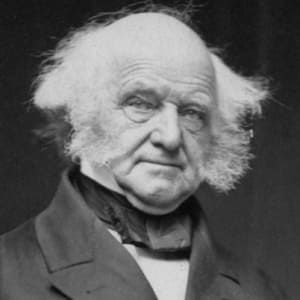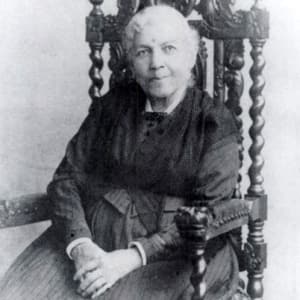
Martin Van Buren
Martin Van Buren was the eighth president of the United States. His shrewd dealings laid the foundations for the Democratic Party and the modern political machine.
Synopsis
Martin Van Buren was born on December 5, 1782, in Kinderhook, New York. He studied law and held various political positions before serving as U.S. senator, as secretary of state and as vice president. He was elected the eighth president of the United States in 1836, but his policies were unpopular and he failed to win a second term. He died on July 24, 1862, in Kinderhook.
Early Life
Martin Van Buren was born on December 5, 1782, in Kinderhook, New York. His parents, Abraham and Maria, were of Dutch descent and modest means. His father was a farmer but also ran a tavern, which frequently served as a political meeting place and where young Martin was first exposed to politics. The boy attended local schools and the Kinderhook Academy until age 14, when his father, unable to afford to send Martin to college, managed to secure him an apprenticeship with a lawyer. He studied law in the subsequent years, and in 1803 was admitted to the bar. Van Buren began his own practice shortly thereafter.
In 1807, Van Buren married his cousin, Hannah Hoes, and the couple would eventually have four children, two of whom would later serve in their father’s Cabinet. Around this time, Van Buren also become more involved in politics, specifically with the so-called Bucktail faction of the Democratic- Republican Party, a group committed to the Jeffersonian concepts of limited government. In 1812, Van Buren was elected to the first of his two terms in the New York State Senate, and in 1815 he was appointed as New York’s attorney general. During this time, he proved himself to be an adept politician, using political appointments and financial contributions to secure votes, and effectively establishing what would prove to be the foundations of the modern political machine.
Political Rise
As Van Buren was finishing his second term in the New York Senate, Hannah died of tuberculosis, leaving him to look after their four children. Despite this personal tragedy, he continued to pursue his political aims and was elected to the United States Senate in 1821. Following the election of 1824, in which John Quincy Adams was elected president, Van Buren and other Democratic-Republicans, including Andrew Jackson, William Crawford and John Calhoun, sought to create a new political party based on the idea of a minimalist government. This group would later evolve into the Democratic Party.
In 1828, Van Buren gave up his Senate seat when he was elected governor of New York. However, he resigned that post only a few months later when Andrew Jackson, whom he had helped win the presidency, selected Van Buren as his secretary of state. Van Buren served Jackson faithfully during his first term, but then resigned as part of a strategy that would allow Jackson to reorganize his Cabinet as a means of ridding himself of John C. Calhoun, with whom Jackson had developed a contentious relationship. Following this reorganization, Jackson rewarded Van Buren’s loyalty and sacrifice by appointing him minister to Great Britain.
In 1832, when Jackson ran for a second term, he selected Van Buren as his running mate. Van Buren was officially nominated later that year in the first-ever Democratic convention, and he and Jackson were easily elected. In 1835, at the end of Jackson’s term, Van Buren was unanimously nominated for president. He ran on the platform that he would essentially continue Jackson’s policies, and in 1836 easily defeated his three opponents from the Whig Party.
The Eighth President of the United States
Van Buren took office in March of 1837 and immediately faced significant challenges. The most significant of these was a financial panic, begun during Jackson’s second term and triggered by the transfer of federal funds from the Bank of the United States to state banks. In the aftermath, hundreds of banks and businesses failed and thousands of people lost their land, making it the worst financial crisis in the nation’s history up to that point. Van Buren pointed the finger primarily at the Bank of the United States and proposed that federal funds instead be transferred to an independent treasury. A measure establishing this treasury would eventually pass years later, but in the interim Van Buren’s political opponents sought to blame him for the crisis.
Another challenge Van Buren faced during his presidency was rising tension between the U.S. and British governments over a border dispute. Skirmishes along the Maine–New Brunswick border were bringing the two nations to the brink of war, but Van Buren sought to resolve the issue diplomatically, sending an envoy to negotiate a treaty with Great Britain. Though the negotiations were ultimately successful, those who had desired that the United States take a stronger stance in the matter counted this among Van Buren’s failings. Further wounding Van Buren’s political image, both without his party and within, were Van Buren’s stance against the annexation of Texas and his continuation of Jackson’s policies against Native Americans, which many people viewed as inhumane.
In 1840, Martin Van Buren was unanimously nominated as the Democratic candidate, but the challenges and controversies of his first term proved too great to overcome (they had also earned him the nickname “Martin Van Ruin”). He was soundly defeated by the candidate from the Whig Party, William Henry Harrison, failing to carry even his home state of New York. Van Buren finished out his term, and in 1841 returned to his “Lindenwald” estate in Kinderhook.
Later Years
Four years after his failed bid for a second term, Van Buren expected to once again receive the Democratic nomination, but was passed over in favor of James K. Polk, whose support of the annexations of Texas and Oregon was more popular than Van Buren’s stance against it. Van Buren ran again in 1848 as a member of the Free Soil Party, which was made up primarily of various antislavery factions, but he received only 10 percent of the vote.
Van Buren spent much of his later years travelling extensively, then returned to Kinderhook and wrote his memoirs. He died on July 24, 1862, at the age 79, and was buried in the Kinderhook Cemetery.
Related Videos
John Quincy Adams – Pushed Into Politics(TV-14; 1:07)




